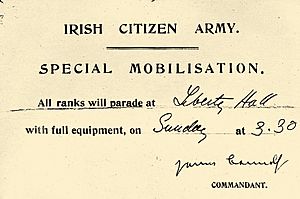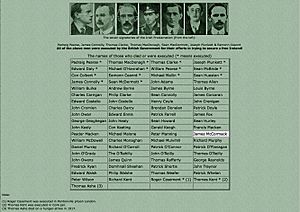James McCormack (Irish revolutionary) facts for kids
Quick facts for kids
James McCormack
|
|
|---|---|

James McCormack, Dublin, 1908
|
|
| Born | 24 November 1877 Lisdornan, County Meath, Ireland
|
| Died | 26 April 1916 (aged 38) Dublin, Ireland
|
| Political party | Labour Party |
| Spouse(s) |
Ann Rooney
(m. 1908) |
| Children | 3 |
| Military service | |
| Allegiance | |
| Rank | Lieutenant |
| Battles/wars | Easter Rising † |
James McCormack (1877–1916) was an important Irish activist and revolutionary. He was part of the Irish Citizen Army. He fought and died during the Easter Rising in 1916.
Contents
James McCormack's Early Life
James McCormack was born on November 24, 1877. His parents were Michael and Mary. James grew up in Lisdornan, County Meath, Ireland. He lived there with his younger brothers Hugh, John, Michael, and his sister Margaret.
In 1904, James moved to Baldoyle, County Dublin. He started working at the Metropolitan Baldoyle Race Company Limited. He was a skilled groundskeeper and steward. He helped build and maintain the race tracks. He even created a new five-furlong gallop. This gallop became famous as one of the best in north-west Europe. Before this, he worked at The Bellewstown Racecourse, which is the oldest racecourse in Europe.
Growing up in Meath, James learned a lot about hunting and weapons. He hunted grouse, geese, ducks, and deer. These skills were very useful later. He used them to train men and women in the Irish Citizen Army. He worked alongside Captain Jack White.
In 1908, James married Ann Rooney. She was from the Portmarnock-Malahide area. They had three sons: Michael (born 1909), Joseph (born 1911), and James (born 1914). The family lived in ‘Sutton Cottages’ on Station Road. In 1911, Ann's two brothers-in-law and a man named William Kennedy lived with them. These men later joined the Fingal branch of the ICA.
What Was the Irish Citizen Army?
James McCormack, Joseph McDonagh, and Michael Nolan were socialists and activists. They helped create the ITGWU (Irish Transport and General Workers' Union). In 1913, these three men joined the Irish Citizen Army (ICA). The ICA was started by James Larkin, James Connolly, and Jack White. It was formed to protect workers and strikers. This was especially important during the Lockout of 1913, when workers faced harsh treatment.
The Irish Citizen Army was a group of armed and well-trained men and women. Their main goal was to defend workers. They wanted to protect them from the police. The ICA had about 250 members. Soon, their goal changed to creating an independent and socialist Irish nation. Other famous members included Constance Markievicz and Seán O'Casey.
The ICA uniform was dark green. They wore a slouched hat with a badge. The badge looked like the Red Hand of Ulster. Their flag was called the Plough and the Stars. This flag showed that a free Ireland would control its own future. It meant from the land (plough) to the sky (stars). This flag was flown by the Irish Citizen Army during the 1916 Rising.
The Easter Rising of 1916
On Easter Monday, April 24, 1916, the Easter Rising began. Lieutenant James McCormack was the Military Commanding Officer of the Baldoyle, Sutton, and Howth branch of the ICA. He led his group of men to Liberty Hall in Dublin. They went there to join the uprising against British rule. Other members of his group were already cutting off police communications to London.
About 1,200 members of the Irish Volunteers and Irish Citizen Army gathered in Dublin. This included women from Cumann na mBan. The British forces brought 20,000 extra soldiers. They also had artillery and a gunboat. About 400 Volunteers and Citizen Army members met at Liberty Hall. They were led by Commandant James Connolly. This was the rebel headquarters. Other leaders there included Patrick Pearse, Tom Clarke, and Joseph Plunkett.
McCormack was sent to the General Post Office (GPO). This building is on Sackville Street, which is now O'Connell Street. The Rising lasted for six days. Members of the Irish Volunteers, led by Patrick Pearse, joined the ICA. They also had 200 women from Cumann na mBan. They took over important places in Dublin. They announced that Ireland was now a Republic.
They marched to the General Post Office (GPO). They took over the building and raised two republican flags. Pearse stood outside and read the Proclamation of the Irish Republic. Copies of the Proclamation were put on walls. They were also given to people by Volunteers and newsboys. The GPO became the rebels' main headquarters.
There was fierce fighting in the streets. The rebels fought hard. They slowed down the British advance and caused many injuries. Elsewhere in Dublin, the fighting was mostly sniping and long-range gun battles. The main rebel positions were slowly surrounded. They were also bombed with artillery shells.
Lieutenant McCormack served as a Military Commander. He worked under James Connolly. Connolly was the Commandant and Commander-in-Chief of the Dublin Brigade. McCormack was a member of the Irish Labour Party. He also belonged to the Irish Trades Union Congress. Like Connolly, he believed in socialism.
James McCormack and his group were at the GPO. On Wednesday, April 26, 1916, he was shot by a sniper. He died during that important Easter Week. The exact place where he was killed is recorded as being in the GPO or Moore Lane area. Eleven Citizen Army men were killed during the Rising. They died in areas like City Hall, Dublin Castle, Stephen's Green, and the GPO.
After a week of heavy bombing by British forces, Connolly ordered his men to surrender. He and his Chief of Staff, Michael Mallin, were later executed by a British army firing squad. The ICA members who survived were sent to prisons. They were held in Frongoch in Wales and in English prisons for nine to 12 months.
The ICA was the only rebel group that allowed women to join. Many women became members. The most famous was Countess Markievicz. She became the Honorary Treasurer. She worked under Michael Mallin at St Stephen’s Green. The ICA stopped being a major military force. However, former members wore their uniforms again. They formed a guard of honour at Countess Markievicz's funeral in 1927. They did the same for James Larkin's funeral in 1947.
Remembering James McCormack
James McCormack was buried in Glasnevin Cemetery. Many of his fellow fighters are buried there too. His name is on the memorial. It is also written in Gaelic as ‘Seamus Mac Chormaic’. James McCormack gave his life fighting for Ireland's freedom. His wife, Ann McCormack, passed away in 1928. Her cousin, Cecilia Shaw, then raised their three sons.
James McCormack was given bronze medals after his death. These were for his military service to Ireland. The medals have a green and orange ribbon. They are stamped with the words “Seachtmhain na Casga 1916”. This means "Easter Week 1916".
In 2016, a special plaque was put up to remember James McCormack. It was placed on the Lisdornan/Dardistown boundary. This was exactly 100 years after he was shot. A bridge there was also named the James McCormack Memorial Bridge.
James McCormack was an expert at building and maintaining racecourses. He worked at Bellewstown Racecourse and Baldoyle Racecourse. Both were very famous. In 2016, a commemorative plaque and park bench were placed in his name. They are at the Baldoyle Racecourse Community Garden. Many of his family members attended this event.
A group of houses and a private road are named James McCormack Gardens. This area was built in 1949. James McCormack's son, Joseph, raised his family on that road. James's granddaughter, Ann McCormack, raised her family on Station Road. This was near where James and his family had lived.
In December 2015, a local historian named Philip O’Connor gave a talk. He said that the Baldoyle area produced the only large unit of the Citizen Army. He noted that many of them fought bravely in the 1916 Rising. They also fought for social justice later on.







